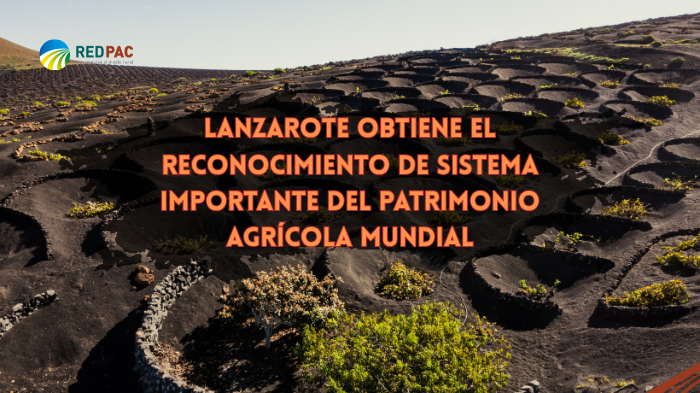
18 de July de 2025
The island has gained recognition thanks to its traditional farming systems on volcanic soil.
- The island has gained recognition thanks to its traditional farming systems on volcanic soil.
- The extreme climatic conditions of the territory and the arid soils have forged a unique and adapted agriculture
- Cultivation on volcanic ash, organogenic sands and volcanic picón has turned three areas of the island into agricultural benchmarks.
The Food and Agriculture Organization of the United Nations (FAO) has awarded Lanzarote the title of Globally Important Agricultural Heritage System (GIAHS) , positioning it as the first European island to join this international network that highlights traditional and resilient agricultural models capable of obtaining the necessary techniques and tools from the natural environment itself.
Lanzarote's agricultural system has been recognized for its originality, efficiency, and sustainability in a harsh climate. The FAO's GIAHS designation gives special recognition to three traditional agrosystems. present on the island:
La Geria: an iconic landscape where vines grow in holes dug in volcanic ash, protected by semicircular stone walls called zocos, which cushion the wind and retain moisture.
El Jable: a growing area on organogenic sands—formed by the remains of living organisms—carried by the wind, where onions, sweet potatoes, and cereals are grown in a dynamic and fragile environment.
Northern sandstone: These are agricultural techniques that use layers of volcanic rock (lapilli) to trap dew and conserve water in dry soils.
These cultivation methods have allowed for centuries:
Producing food without irrigation, in a region that receives less than 150 mm of rain per year.
Conserve native crop varieties such as the Volcanic Malvasia vine, figs, legumes, and cereals.
Integrate native flora into agricultural margins, promoting biodiversity.
Transmit local knowledge orally and practically, while maintaining the island's agricultural identity.
In addition to its productive value, agriculture in Lanzarote plays a key role in the cultural, economic, and environmental spheres. It contributes to rural food security and the maintenance of crops adapted to local climatic conditions, promotes sustainable tourism through agrotourism and value-added products such as wine, and strengthens the island's landscape and cultural identity, framed by protection policies and international recognitions such as the UNESCO Biosphere Reserve and Geopark .
Other SIPAM in Spain
With the addition of Lanzarote in 2025, Spain now has six territories recognized as Globally Important Agricultural Heritage Systems, each with a unique agricultural history and practice:
Añana Salt Valley (Álava) (2017): salt production using an ancestral hydraulic system based on saline springs and wooden canals.
The Axarquía (Málaga) (2017): It is the agricultural practice located on steep slopes where raisins are traditionally produced using manual and sustainable methods.
Territory of Sénia (Castellón-Tarragona) (2018): This is the largest concentration of ancient olive trees in the world, cultivated using inherited techniques.
The Huerta de Valencia (2019) : a historic Islamic irrigation system that allows diversified cultivation in a dense and dry coastal area.
León Mountains (2019): which have an agrosilvopastoral model that integrates forests, pastures and crops, preserving ecological and cultural diversity.
Thanks to them, Spain has become the third country in the world with the most recognized systems, behind only China and Japan, thus consolidating its commitment to preserving agricultural practices that not only sustain rural livelihoods but also protect unique landscapes and ancestral knowledge in harmony with nature.
The GIAHS program was launched by FAO in 2002 with the goal of identifying and protecting unique agricultural systems that combine biodiversity, traditional knowledge, local culture, and environmental sustainability. Since its inception, 95 systems have been designated in 28 countries , recognizing living landscapes that have evolved over centuries through respectful interaction between rural communities and their environment. These systems are now considered key examples in the face of challenges such as climate change, biodiversity loss, and food security.











